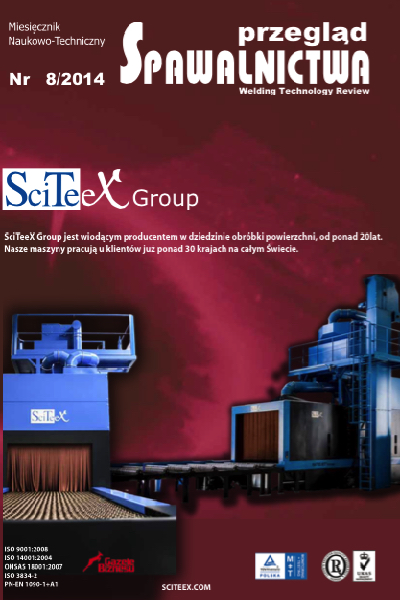The effect of the interface profile on the residual stresses formed in thermally sprayed NiAl coatings on Al2O3 substrate; Wpływ kształtu granicy połączenia na naprężenia własne powstające w natryskiwanych powłokach nial na podłożu ceramiki Al2O3
Main Article Content
Abstract
The physical preparation of a surface material to be coated by the thermal spray processing plays very important role as it affects the bonding force between the coating and substrate. when the coating material has different thermal and physical properties than the substrate the thermal residual stresses are generated in a two material system which may reach the level that promotes the coating delamination or cracking. Another factor influencing the stress state in sprayed coatings may lay in the interface profile between the coating and substrate. we may try to affect this factor by analyzing the profile and texture of the substrate surface to be coated. This way we may influence the residual stress built in a deposited coatings. The aim of this paper is to model and analyze the effect of the substrate surface profile on the residual stresses generated during cooling of thermally sprayed metallic coatings onto the ceramic substrates. The numerical computer simulation has been performed to calculate and compare the residual stress state developed in thermally sprayed metallic/ceramic system (NiAl/Al2O3). The main factor analyzed was the variation in the shape of the interface profile between the coating and substrate. The obtained results have been discussed.
Streszczenie
Przygotowanie fizyczne podłoża materiału do natryskiwania termicznego odgrywa bardzo ważną role ponieważ wpływa na stopień powiązania między utworzoną na podłożu powłoką. Gdy materiał powłokowy ma różne właściwości cieplne i fizyczne w stosunku do podłoża to w takim układzie powstaje określony stan naprężeń własnych termicznych, który w zależności od wielkości i rozkładu może prowadzić do pęknięć w powłoce lub jej delaminacji od podłoża. Istotnym czynnikiem wpływającym na stan naprężeń własnych w natryskanej powłoce może być kształt linii połączenia między powłoką a podłożem. Można mieć na niego wpływ poprzez analizę kształtu czy tekstury podłoża przygotowanego do natrysku. w ten sposób możemy wpływać na stan naprężeń w natryskiwanych powłokach. Celem pracy było zbudowanie modelu obliczeniowego oraz analiza wpływu profilu linii połączenia powłoki z podłożem na rozkład naprężeń własnych termicznych powstających w fazie chłodzenia natryskanej na podłoże powłoki. Przeprowadzono obliczenia numeryczne dla układu powłoki NiAl natryskanej na podłoże ceramiki Al2O3. Głównym analizowanym czynnikiem był charakter profilu granicy połączenia między powłoką a podłożem. wyniki obliczeń naprężeń własnych dla sześciu różnych profili granicy połączenia poddano analizie porównawczej oraz dyskusji otrzymanych wyników.
Downloads
Article Details
Creative Commons CC BY 4.0 https://creativecommons.org/licenses/by/4.0/
Welding Technology Review (WTR) articles are published open access under a CC BY licence (Creative Commons Attribution 4.0 International licence). The CC BY licence is the most open licence available and considered the industry 'gold standard' for open access; it is also preferred by many funders. This licence allows readers to copy and redistribute the material in any medium or format, and to alter, transform, or build upon the material, including for commercial use, providing the original author is credited.
References
Berndt M.L., Berndt Christopher C.: Thermal spray coatings. Brookhaven national Laboratory, State University of New York, Stony Brook, 2003.
Westbrook J.H., Fleischer R.L.: Structural Applications of Intermetallic Compounds. Edited by 1995, 2000 John Wiley & Sons Ltd.
Trinh D., Müller M.: Aluminides. 4H1609 Functional Materials, Project Report, KTH, 2002.
Chmielewski T., Golański D.: The new method of in-situ fabrication of protective coatings based on FeAl intermetallic compounds. Journal of Engineering Manufacture Part B. April 2011, 225: pp. 611-616.
Gontarz G., Chmielewski T., Golański D.: Modyfikacja natryskiwanych powłok aluminiowych na stali skoncentrowanym źródłem ciepła. Przegląd Spawalnictwa nr 12/2011, pp. 52-54.
Gontarz G., Golański D., Chmielewski T.: Powłoki intermetaliczne z grupy Fe-Al wytwarzane metodami spawalniczymi. Mechanik nr 08/09/2012, pp. 769-771.
Chmielewski T., Golański D.: wpływ tytanowej warstwy metalizacyjnej osadzonej detonacyjnie na ceramice na stan naprężeń powstających w lutowanych złączach Al2O3-stal. Przegląd Spawalnictwa nr 10/2010, s. 56-60.
Golański D., Chmielewski T., Gontarz G.: Badania zwilżal- ności ceramiki metalizowanej metodami natrysku cieplnego. Przegląd Spawalnictwa, no. 8(2013), pp. 65-69.
Davis J.R.: Handbook of Thermal Spray Technology, ASM International, 2004.
Chmielewski T.: wykorzystanie energii kinetycznej tarcia i fali detonacyjnej do metalizacji ceramiki, Prace naukowe Pw. Seria Mechanika, Zeszyt 232 (2012), pp. 1-155.
Chmielewski T., Golański D.: Modelowanie numeryczne naprężeń własnych w złączach Al2O3Ti oraz Al2O3(Ti+Al2O3) formowanych podczas natryskiwania detonacyjnego. Przegląd Spawalnictwa, nr 9(2009), pp. 5862.
Chmielewski T., Golański D., Gontarz G.: Pomiar naprężeń własnych powłok metalicznych natryskiwanych termicznie. Przegląd Spawalnictwa nr 12/2011, s. 59-64.
Zimmerman J., Lindemann, Z., Golański D., Chmielewski T., włosiński w.: Modeling residual stresses generated in Ti coatings thermally sprayed on Al2O3 substrates. Bulletin of the Polish Academy of SciencesTechnical Sciences, Vol. 61, no. 2, 2013, pp. 515-525.
Golański D., Chmielewski T., Gontarz G., Zimmerman J., Włosiński w.: Badania naprężeń własnych w powłokach natryskiwanych metodą HVOF, Przegląd Spawalnictwa, no.11(2013), pp. 30-35.
Hutchinson J.w., Evans A.G.: On the delamination of thermal barrier coatings in a thermal gradient. Surface and Coatings Technology 149 (2002), pp.179-84.
Houdeau D, Steckenborn A., Zhang J-M, Kiesewetter L.: Eigenspannungen in Mikrosystemen, in Proc. Conf. Residual Stresses, Frankfurt DGM Informationsgesellschaft, Verlag, 1992. p. 23.
Araujo P., Chicot D., Staia M., Lesage J.: Residual stresses and adhesion of thermal spray coatings, Surface Engineering vol.21(2005), no. 1, 35-40.
Li D., Lin D., Liu Y.: Effect of temperature on the tensile properties and dislocation structures of FeAl alloys. Materials Science and Engineering A249 (1998), 206-216.
Reddy B.V., Deevi S.C.: Thermophysical properties of FeAl (Fe-40 at.%Al). Intermetallics 8 (2000), pp. 1369-1376.
Schneibel J.H.: Schneibel J.H. et al, editor. Processing, Properties, and Applications of Iron Aluminides. warrendale, PA:
TMS, 1994. p. 329.
Totemeier T.C., wright R.n., Swank w. D.: FeAl and Mo-
Si-B Intermetallic Coatings Prepared by Thermal Spraying. Idaho National Engineering and Environmental Laboratory. Report.
Choo H., Bourke M.A., Daymond M.R.: A finite element analysis of inelastic relaxation of thermal residual stress in con- tinuous fiberreinforced composites. Comp. Sci. & Tech., vol. 61 (12), pp. 1757- 1772, 2001.
